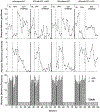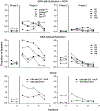Resurgence following differential reinforcement of alternative behavior implemented with and without extinction
- PMID: 32133673
- PMCID: PMC8111434
- DOI: 10.1002/jeab.588
Resurgence following differential reinforcement of alternative behavior implemented with and without extinction
Abstract
In the clinic, differential reinforcement of alternative behavior (DRA) often involves programming extinction for destructive behavior while reinforcing an alternative form of communication (e.g., a functional communication response); however, implementing extinction can be unsafe or impractical under some circumstances. Quantitative theories of resurgence (i.e., Behavioral Momentum Theory and Resurgence as Choice) predict differences in the efficacy of treatments that do and do not involve extinction of target responding when reinforcement conditions maintaining alternative responding worsen. We tested these predictions by examining resurgence following two DRA conditions in which we equated rates of reinforcement. In DRA without extinction, target and alternative behavior produced reinforcement. In DRA with extinction plus noncontingent reinforcement, only alternative behavior produced reinforcement. We conducted this study in a reverse-translation sequence, first with participants who engaged in destructive behavior (Experiment 1) and then in a laboratory setting with rats (Experiment 2). Across both experiments, we observed proportionally lower levels of target responding during and following the DRA condition that arranged extinction for the target response. However, levels of resurgence were similar following both arrangements.
Keywords: behavioral momentum theory; destructive behavior; differential reinforcement of alternative behavior; extinction; resurgence; resurgence as choice; reverse-translational.
© 2020 Society for the Experimental Analysis of Behavior.
Figures





Similar articles
-
Evaluation of resurgence following differential reinforcement of alternative behavior with and without extinction in a human operant model.J Exp Anal Behav. 2024 Nov;122(3):351-361. doi: 10.1002/jeab.4222. Epub 2024 Oct 24. J Exp Anal Behav. 2024. PMID: 39448553
-
Examining resurgence in rats following expanded-operant treatments.J Exp Anal Behav. 2023 Sep;120(2):186-203. doi: 10.1002/jeab.870. Epub 2023 Jun 20. J Exp Anal Behav. 2023. PMID: 37337718 Free PMC article.
-
Behavioral momentum theory fails to account for the effects of reinforcement rate on resurgence.J Exp Anal Behav. 2016 May;105(3):375-92. doi: 10.1002/jeab.207. J Exp Anal Behav. 2016. PMID: 27193242 Free PMC article.
-
Resurgence as Choice.Behav Processes. 2017 Aug;141(Pt 1):100-127. doi: 10.1016/j.beproc.2016.10.006. Epub 2016 Oct 26. Behav Processes. 2017. PMID: 27794452 Free PMC article. Review.
-
Applied implications of reinforcement history effects.J Appl Behav Anal. 2009 Spring;42(1):83-103. doi: 10.1901/jaba.2009.42-83. J Appl Behav Anal. 2009. PMID: 19721732 Free PMC article. Review.
Cited by
-
Resurgence Following Traditional and Interdependent Differential Reinforcement of Alternative Behavior.Behav Dev Bull. 2021 Apr;26(1):29-42. doi: 10.1037/bdb0000101. Behav Dev Bull. 2021. PMID: 34594471 Free PMC article.
-
Modeling Behavioral Persistence with Resurgence as Choice in Context (RaC2): A Tutorial.Behav Anal Pract. 2023 Apr 25;16(2):640-651. doi: 10.1007/s40617-023-00796-y. eCollection 2023 Jun. Behav Anal Pract. 2023. PMID: 37187845 Free PMC article.
-
Updated Recommendations for Reinforcement Schedule Thinning following Functional Communication Training.Behav Anal Pract. 2023 Oct 11;17(1):87-106. doi: 10.1007/s40617-023-00863-4. eCollection 2024 Mar. Behav Anal Pract. 2023. PMID: 38405284 Free PMC article. Review.
-
Translating quantitative theories of behavior into improved clinical treatments for problem behavior.Behav Processes. 2022 May;198:104639. doi: 10.1016/j.beproc.2022.104639. Epub 2022 Apr 9. Behav Processes. 2022. PMID: 35405305 Free PMC article.
-
Response-strengthening effects of same- and different-context DRA training: The effects of two disruptors.J Exp Anal Behav. 2022 Nov;118(3):376-397. doi: 10.1002/jeab.796. Epub 2022 Aug 30. J Exp Anal Behav. 2022. PMID: 36054301 Free PMC article.
References
-
- Betz AM, & Fisher WW (2011). Functional analysis: History and methods. In Fisher WW & Roane HS (Eds.), Handbook of applied behavior analysis (pp. 206–255). Guilford.
Publication types
MeSH terms
Grants and funding
LinkOut - more resources
Full Text Sources

